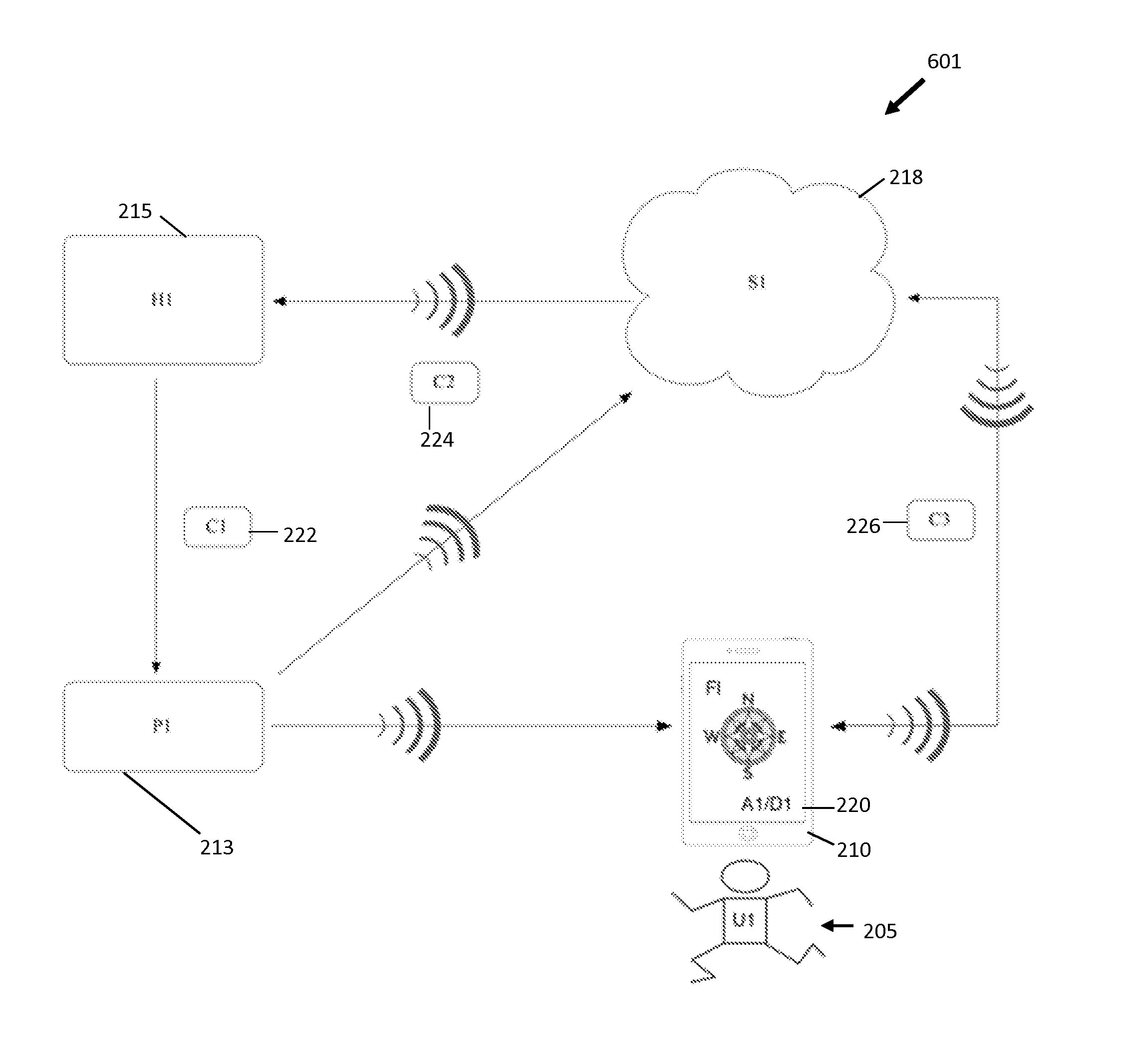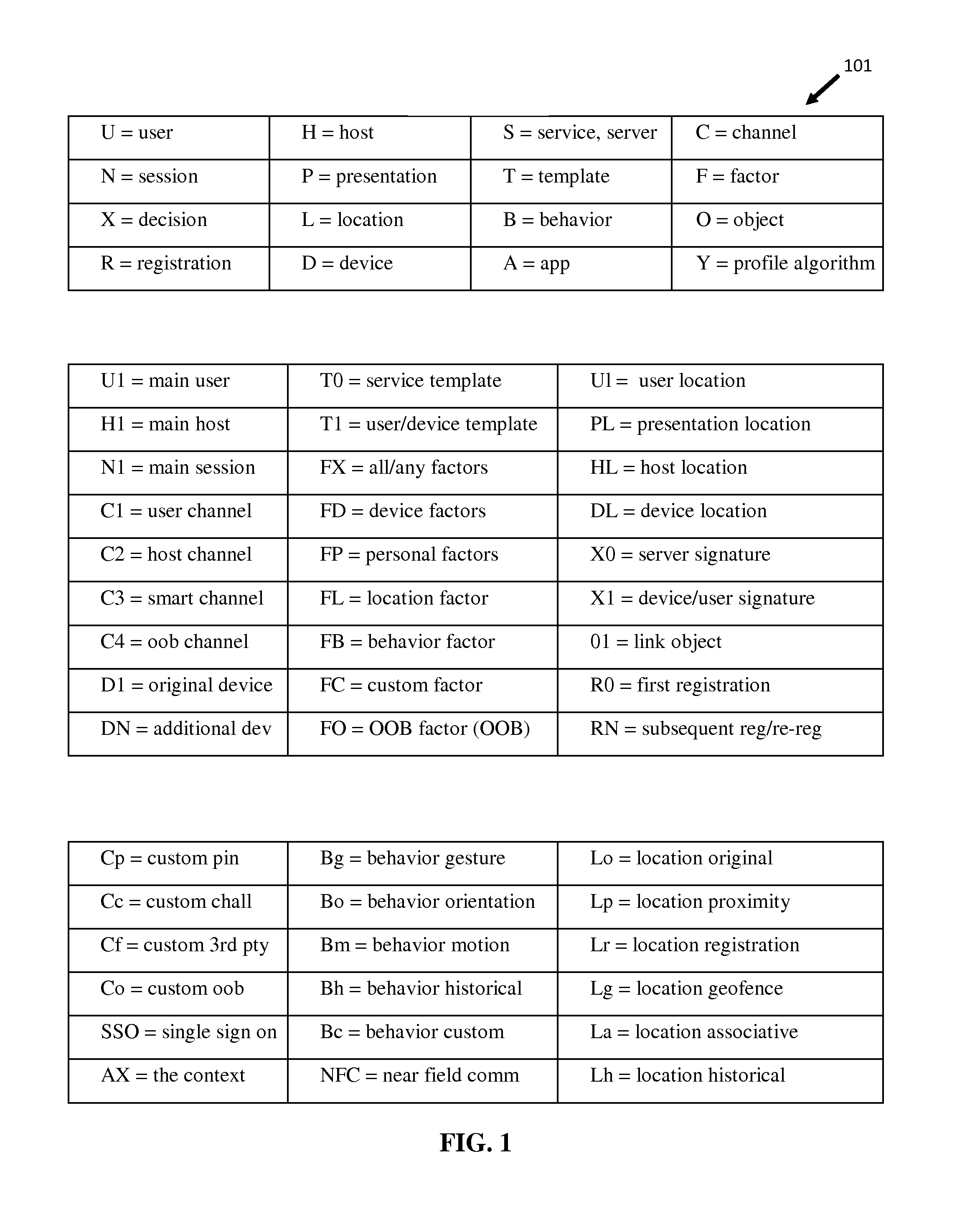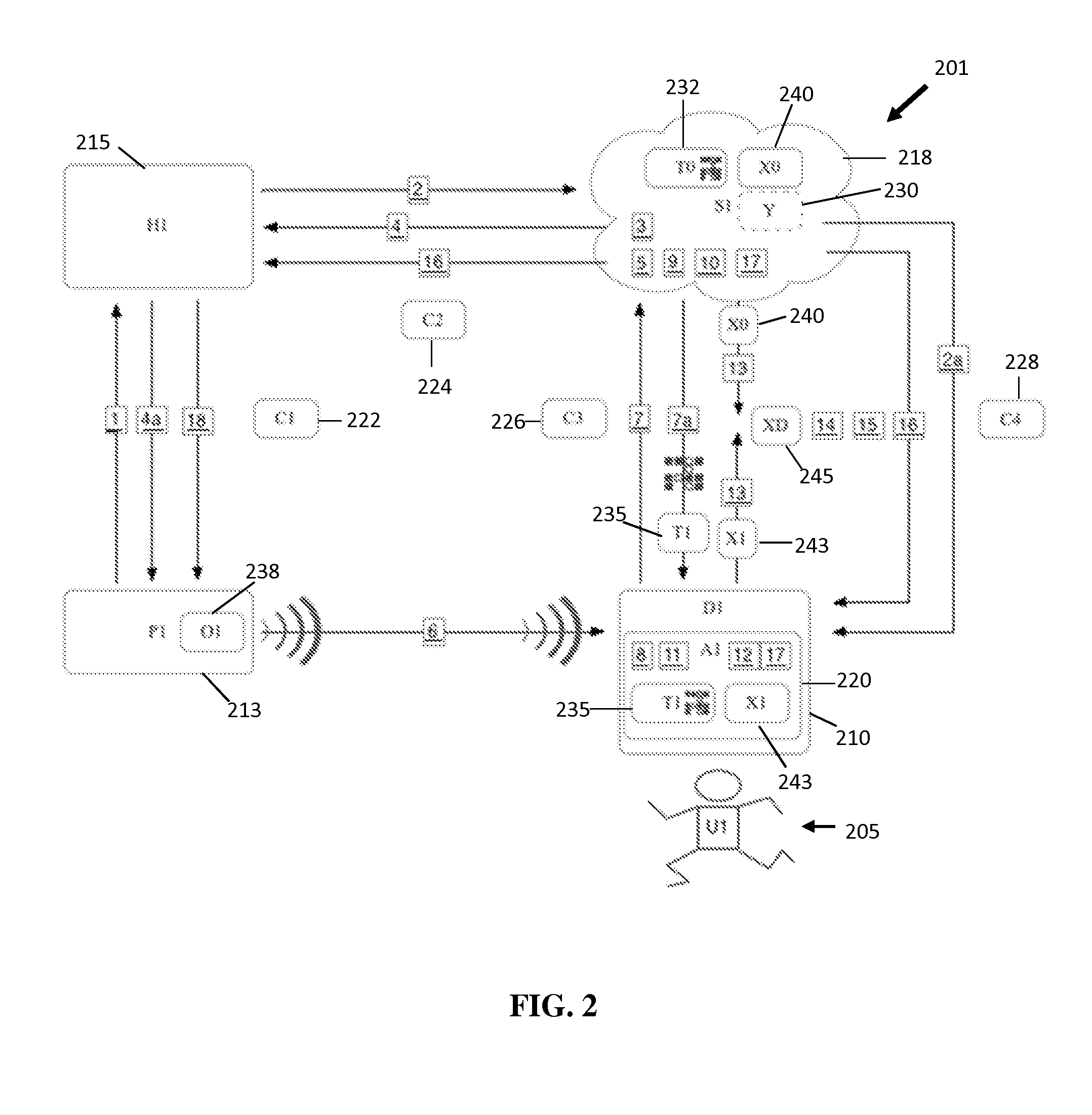Unfortunately, most traditional authentication methods have various flaws and complications.
For example, many conventional authentication methods are either too costly or too cumbersome to appropriately scale and be adopted ubiquitously by the marketplace.
Additionally, current authentication methods and systems are not up to the security challenge modern hackers
pose and the do not have the
usability or privacy features that users require.
Furthermore, contemporary multi-factor or two-factor solutions fail to recognize and
exploit the fact that user security is a fabric, not a thread—i.e., composed of multiple variables, rather than, a
single factor or variable.
This ignorance of contextual realities among devices, sites, users, applications, and networks in businesses and social environments leaves most solutions woefully inadequate to meet the authentication security challenges at hand.
Although additional methods may attempt to address such issues by collapsing the acts of identification and authentication into a
single process, these methods inherit the same liabilities as any other
single point of failure or federated systems, regardless of the sophistication or novelty of the flow.
The challenge has always been to balance advanced security with enhanced
usability.
The challenge, however, is to create a simple, mutual, contextual
verification without depending upon or exposing the process to the traditional
security solution shortcomings.
Because conventional means of authentication include the
pairing of discrete and private elements of a user, device, or session with their meanings (key-value pairs), these methods inappropriately collapses the independent notions of identification (self-reported) and authentication (externally verified).
As a result, private user identity information is potentially exposed for capture, replay, prediction, theft or misuse, in service of its
verification.
A second challenge to create an ideal and innovative authentication method is to utilize the
mobile device in a
security context for what is designed for and capable of: being an interactive extension to and participant within the context of the user, site / app and session authentication.
Previous security solutions were seen as one or more
layers or cumbersome steps in the end-user security flow.
These challenges, in sum, have represented a barrier to those looking for solutions and have never been overcome by conventional methods.
As a result, there has been no de facto technique adopted in the field of end-user multi-factor authentication that simultaneously solves the security,
usability, and interactivity challenges stated herein.
While Hito discloses verification and authentication techniques that go beyond the traditional username /
password scheme, Hito fails to utilize contextual factors in a defined user session (e.g., behavioral factors, location factors, custom factors) that would aid in strengthen the verification process.
However, like the Hito reference, Harris fails to utilize contextual factors based upon a defined user session that would strengthen the verification process.
It is this inability to innovate beyond this convention that supports the majority of breaches, hacks and failures that plague current authentication methods, including these, in practice at present.
Without achieving a dynamic, context-aware treatment of non-identifying authentication factors mutually asserted in a triangulated (versus unidirectional) framework, there can be no innovation beyond convention nor a viable inventive solution to the failures of prior art.
However, these references also tend to fall into a definable set of inadequate approaches, dating back to antiquated security notions from the early to mid-20th century.
Unfortunately, these references embody the multi-purpose capabilities within stale authentication paradigms, models of shared-secret, security by obscurity and flat, non-context-aware, unidirectional
processing, regardless of their out-of-band (OOB) characteristics or flow.
Specifically, the shortcomings of the references listed above fall under these areas: (1) cumbersome usability for the end-user; (2) user enrollment process that exposes weakest initial trust link; (3) lack of credential integrity through multi-perspective assertions; (4) lack of awareness of credential, user or device location, proximity, history, or movement; (5) decreased
user privacy through repeat, paired transmission of static identifiers; (6) lack of credential flexibility or diversity; (7) failure to achieve ubiquity across devices, session types; (8) improper flow of credentials (from
secure channel to insecure); (9) unilateral assertion authority (single lookup / match process); (10) lack of credential
context awareness (time, location, behavior); (11) lack of
user control over credential depth, composition and process; (12) over-identification of the user or device during authentication; (13) unnecessary transmission of user or device identifying data key value pairs; (14) heavyweight components such as PM (public / private key
encryption), digital certificates and permanent keys that require distribution,
obfuscation and
revocation management on the
mobile device; (15) single directional flow of key-value credentials towards an single authoritative target; (16) single perspective or measurement of the context credentials; and (17) non-interactive relegation of the
smart device to a simple
decode and forward utility.
Various embodiments disclosed previously have failed to adequately resolve the present security needs, as evidenced by the ongoing security attacks successfully conducted by hackers and criminals.
In addition, the solutions proposed by current security solutions fail to solve the following problems, namely: (a) authentication is traditionally
shared secret, static, and subject to interception, replay or prediction based on persistent information only obfuscated by
encryption or session flavoring; (b) authentication security is expensive, cumbersome, difficult for users to understand or use; (c) authentication relies on
obfuscation,
encryption, user skill / custody or secrecy to be effective; (d) credentials are usually fixed, sequential and single-
mass in depth, intelligence and context; (e)
security information flows backwards, over primary, predictive or known channels such as the browser, together as key-value pairs, towards the unilateral authority in the process; (f) the authentication decision relies upon a unilateral observation, interrogation, lookup-match or single authoritative assertion of credentials, usually in a
client-
server patriarchal relationship between the identifier and the one being identified.
Specifically, solutions proposed in the references
list above using encoded Quick Response (QR) images and
mobile device scanning to identify or authenticate a user or device, such as the Hito reference and the like, are insufficient due to the following limitations and inferior methods: (a) reliance upon heavily encoded, encrypted, or obfuscated content within the image or QR code itself such as webserver, user, device, identity or session information—and the integrity and secrecy of that object and its transmission being essential for its effectiveness to authenticate; (b) reliance upon expensive, static, seeded, embedded credentials on the mobile device (such as a digital
certificate or public / private key pair) that must be managed to provide the user /
device identifiers as opposed to performing a real-time, dynamic, purpose-built, interactive assertion of those identities and contexts; (c) reliance on a separate set of those credentials above (b) being deployed, seeded, managed and associated for each of a user's multiple mobile devices; (d) unidirectional flow of object presentation to scan to transmit towards the authoritative service on the back-end, assumes either complete encrypted integrity of the process or complete
decomposition isolation, and inspection of the credentials by the authority against a stored
database of literal data; (e) the former approach (in (d)) eliminates the
mobile computing device role or value in the process, as imply a catch and forward mechanism without
context awareness or mutual
decision making; (f) the latter approach (in (d)) burdens the authority for making the unilateral authentication decision in isolation with literal credentials, opening path for
reverse engineering, replay or prediction; (g) the store-and-forward approach denies the
process interaction and richer, smarter awareness of
multiple factors in depth within the fabric of the session context; (h) the reliance on the host
server (
presentation layer) to interact with the encoded content provide opportunity for inspection, hack, replay, capture, modification, compromise; (i) the reliance on encryption requires equal and opposite decryption and / or re-encryption capabilities of the
mobile computing device, thus spreading the logic of the process remotely and
exposure to hack; (j) the risk of collapsing and co-mingling of identity and authentication data as the process sends identifiers along the same wire through the code, mobile and messaging to the authoritative
server provides numerous opportunities for
attack, questionable integrity and lack of privacy; (k) in service of excessive usability in collapsing the login scan (self-reported) with the authentication test (static stored phone credential), the limitation of the overall process for the sole purpose of granting or denying a user access to a resource without relation to additional identity or authentication methods (i.e., no longer a defense-in-depth layer) results in the prior art being a
single point of failure; (l) lack of proper
triangulation, interrogation, measurement and interdependent
decision making with respect to the source, integrity and status of the authentication context; (m) failure to treat authentication as a context, simply a set of credentials to be forwarded; (n) failure to triangulate physical and digital assumptions on location, proximity and behavior, from multiple sources and perspectives; and (o) failure to actively involve and engage the user, device, session context, location, proximity, behavior and
triangulation context in the authentication process.
 Login to View More
Login to View More  Login to View More
Login to View More 


